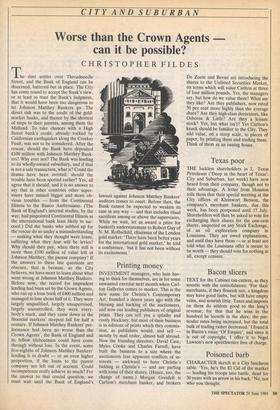Printing money
INVESTMENT managers, who hate hav- ing to think for themselves, are in for some unwanted exercise next month when Carl- ton Galleries comes to market. This is the new name for Christie's Contemporary Art, founded a dozen years ago with the blessing and backing of the auctioneers, and now our leading publishers of original prints. They can sell you a splashy and costly Hockney, but most of their business is in editions of prints which they commis- sion, as publishers would, and sell — mostly by mail order, almost half abroad. Now the founding directors, David Case, Myles Cooke and Charles Farrell, have built the business to a size where the auctioneers fear apparent conflicts of in- terests — awkward to have Christie's bidding at Christie's — and are parting with some of their shares. (Hence, too, the change of name.) Morgan Grenfell is Carlton's merchant banker, and brokers De Zoete and Bevan are introducing the shares to the Unlisted Securities Market, on terms which will value Carlton at three of four million pounds. Yes, the managers say, but how do we value them? What are they like? Are they publishers, now rated 50 per cent more highly than the average share? Are they high-class decorators, like Osborne & Little? Are they a leisure stock? Yes, but what isn't? Yet Carlton's knack should be familiar to the City. They add value, on a steep scale, to pieces of paper, by printing them and trading them. Think of them as an issuing house.


























































 Previous page
Previous page